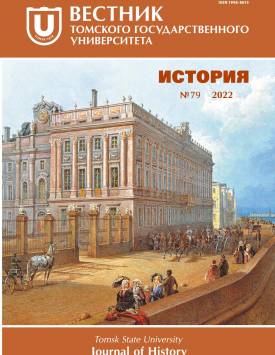To a question of the Yeniseian ethnogenesis
The article is devoted to the problem of the Yeniseian ethnogenesis. This question has been studied mainly by linguists when compared with other studies. The main aim of this paper is to compare three well-known linguistic hypotheses with the genetic conclusions on the indicated problem and to reveal the opinions coincidence of both linguists and geneticists. The most famous linguistic assumptions concerning the place of Yeniseian language (the Ket language) among other languages are described in the article: 1. Availability of connection of Yeniseian language with the languages of the indigenous peoples of Siberia; 2. Availability of connection of Yeniseian language with the languages of the indigenous peoples of North America; 3. Availability of connection of Yeniseian language with the Sino-Tibetan languages; 4. Availability of connection of Yeniseian language with other languages; 5. The Ket language is an isolated one. Based on this brief scheme it is possible to study the connections of the Yeniseians with the Siberian, North American and Sino-Tibetan indigenous peoples from the genetic viewpoint. The relationships of the Yeniseians (the Kets) with many peoples of Southern Siberia are detected due to the genetic research. The genetic analysis of admixture was used to indicate the above-mentioned relationships. The comparison was carried out by means of the study of DNA belonging to different populations. The obtained statistic data testify decisively that the Yeniseian genetic component is connected with the paleosiberian population which was presented within 2-3 thousand years by Yeniseian peoples. In general, the genetic images of investigated populations of South Siberia show that in the gene pool there is the genetic substrate received from the native paleosiberian peoples inhabiting the territory of present Tuva, Khakassia, Altai, South of Krasnoyarsk region and Tomsk region. The genetic link of the Yeniseian and North America native peoples is obvious. The genetic studies of the connection of the Yeniseian and Sino-Tibetan population are absent. The linguistic hypotheses on relationships of the Yeniseian and indigenous population of Siberia and North America are generally confirmed by the presented genetic data. It is impossible to compare linguistic and genetic standpoints concerning the affinity of the Yeniseian and the Sino-Tibetan peoples because of the genetic data absence. Thus, we have a reason to assert more confidently about the relations of the Yeniseian population primarily with native peoples of South Siberia and North America. The authors declare no conflicts of interests.
Keywords
ethnogenesis, ethnology, yeniseian population, native peoples, an interdisciplinary researchAuthors
| Name | Organization | |
| Kolesnikova Svetlana Yu. | Siberian State Medical University | svetlana_kolesnikova_64@mail.ru |
| Kharkov Vladimir N. | Tomsk National Research Medical Center, Russian Academy of Sciences | vladimir-kharkov@medgenetics.ru |
| Valikhova Larisa V. | Tomsk National Research Medical Center, Russian Academy of Sciences | larisa_ermizova9@mail.ru |
References

To a question of the Yeniseian ethnogenesis | Tomsk State University Journal of History. 2022. № 79. DOI: 10.17223/19988613/79/20
